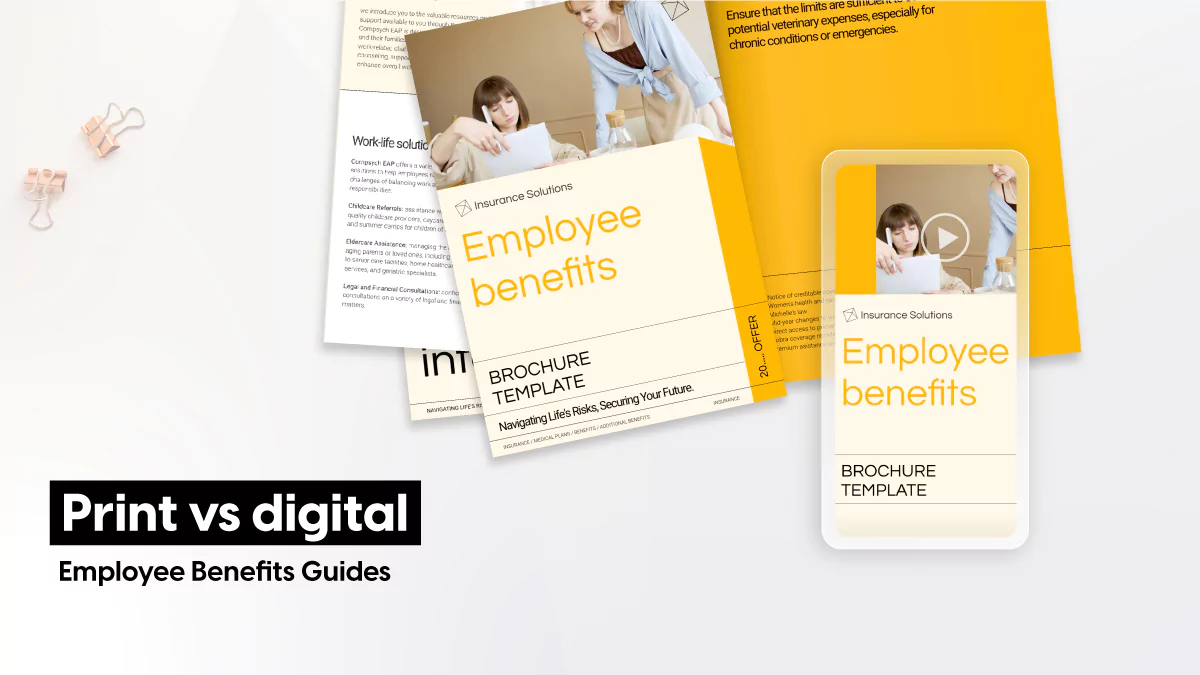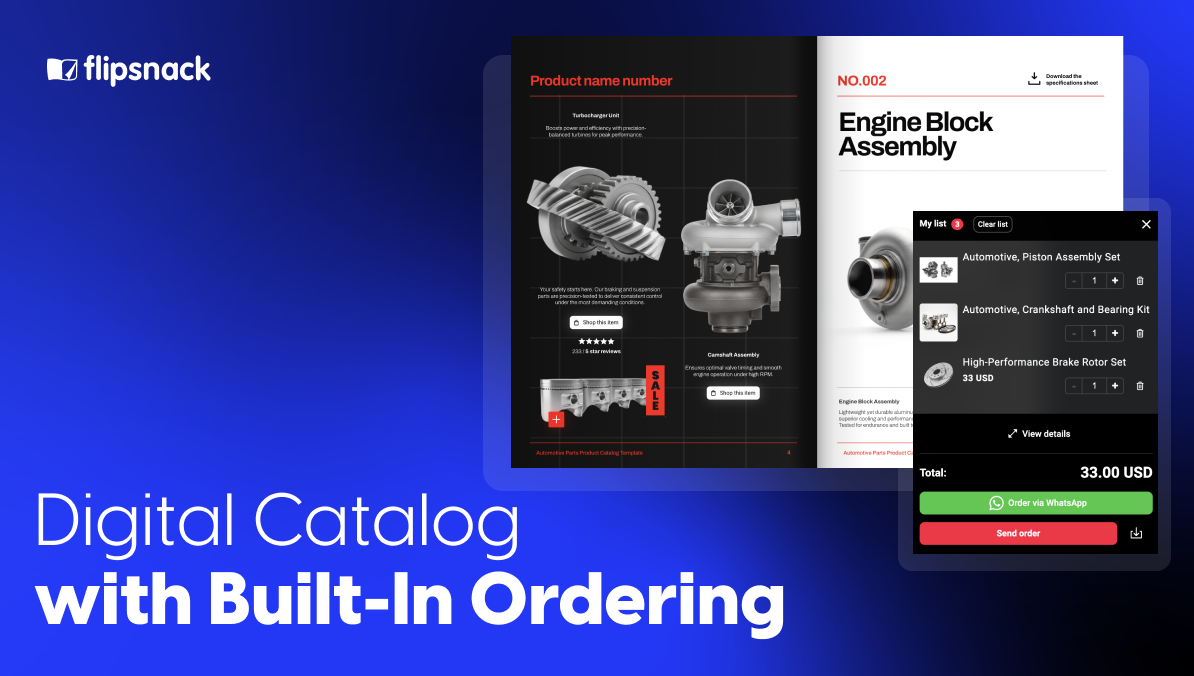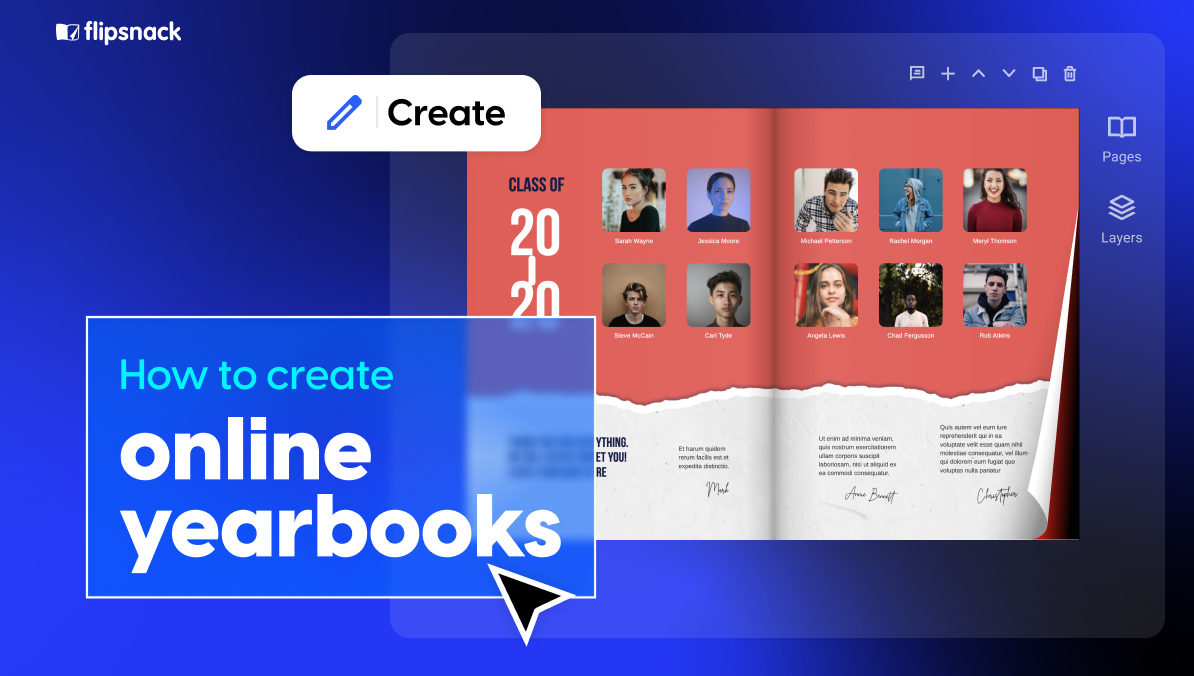Digital Employee Benefits Guides: A Modern Alternative to Printed & PDF Booklets
Published on: May 15, 2024
Last updated: November 27, 2025
Employee benefits have always been a core part of an insurance broker’s value proposition. Whether you support five employer groups or fifty, you’re expected to package complex plan details into clear, engaging materials that employees can actually understand—and use—during open enrollment and beyond. For years, printed booklets and static PDFs have been the standard format for delivering this information. They’re familiar, easy to distribute, and many brokers still rely on them today.
But the expectations of employees—and the needs of the employers you serve—are changing. More decision-making happens on mobile devices. More employees want information that’s easy to navigate, visually clear, and available on demand. And more HR teams now expect their brokers to provide not just benefits expertise, but communication tools that help increase employee engagement and utilization.
That’s where digital employee benefits guides come in. They don’t replace print entirely, and they don’t eliminate the need for downloadable PDFs. Instead, they give brokers a modern way to present benefits information—one that’s interactive, mobile-friendly, trackable, and effortless to update across multiple client groups.
In this guide, we’ll compare printed, PDF, and digital employee benefits booklets, explore the growing shift toward digital delivery, share a real-world case study from an insurance brokerage, and show you how easily you can create digital benefits guides for your clients using Flipsnack.

Printed vs. digital employee benefits guides
| Criteria | Printed guides | Digital flipbook guides |
|---|---|---|
| Production time | Slow—requires design, printing, shipping | Fast—upload or use templates and publish instantly |
| Update flexibility | Zero—any change requires reprinting | Instant updates; link stays the same for all employees |
| Cost-efficiency | High printing + reprint costs | No printing costs; scalable across all employer groups |
| Employee access | Physical copy only | Accessible anytime via link, QR code, or intranet embed |
| Engagement tracking | None—not possible with print | Full analytics: views, clicks, reading time, drop-offs |
| Interactivity | Static text and images | Videos, pop-ups, tooltips, links to enrollment portals |
| Scalibility for brokers | Difficult for many employer groups | Easily duplicated, templated & customized across clients |
Printed employee benefits guides: why brokers still use them
Printed employee benefits guides have been a staple in the insurance industry for decades—and for good reason. Even with the rise of digital communication, printed materials continue to play a valuable role in how brokers support employer groups during open enrollment.
A tangible experience employees appreciate
Printed guides offer something digital formats can’t replicate: a physical, tangible booklet employees can hold, flip through, and reference at their convenience. For certain industries—manufacturing, healthcare, education—and for employees with limited digital access, printed materials remain an effective way to ensure everyone receives the same information.
Ideal for onboarding and open enrollment packets
Many brokers still assemble printed packets for new hires or major enrollment events. These kits help mark moments of transition, giving employees something substantial they can take home, share with family members, or keep on their desks.
No digital learning curve
Not all employee groups are equally tech-savvy. Printed booklets remove barriers and make benefits communication accessible—even in environments where mobile or computer usage is limited.
Limitations of printed benefits guides
While printed benefits guides remain valuable, they come with practical challenges that brokers know all too well—especially when supporting multiple employer groups.
High production and shipping costs
Designing, printing, and mailing booklets quickly becomes expensive, particularly when updates or last-minute changes force reprints.
Impossible to update after distribution
Once printed, a booklet is final. Any correction—no matter how small—requires reprinting or relying on HR to distribute supplemental materials.
Limited personalization at scale
Customizing printed guides for each employer or employee segment becomes time-consuming and cost-prohibitive.
No analytics or usage data
There’s no way to know:
- whether employees read the guides
- which sections they focus on
- or where confusion arises
For brokers trying to demonstrate value or improve year-over-year engagement, printed materials alone provide little insight.
Pain points of traditional PDF guides
- No visibility into engagement: Once a PDF is emailed, brokers can’t see who opened it, what sections were viewed, or whether employees engaged with it at all. This makes it difficult to prove value or improve communication year over year.
- Poor mobile experience: PDFs aren’t built for phones—employees must zoom, scroll, and struggle through dense pages. This leads to confusion and more follow-up questions for brokers.
- Hard to update and maintain: Any typo or plan change requires exporting a new PDF and resending it to every employer group. Version control becomes messy, and employees often reference outdated files.
- Static and overwhelming: PDFs are long, text-heavy, and lack interactivity. Employees skim or abandon them, leading to misunderstood benefits and preventable HR inquiries.
- No personalization at scale: Tailoring PDFs for different locations, plan types, or employee groups requires creating multiple versions manually—time-consuming and inefficient for brokers managing many clients.
- Not ideal for HR platforms or intranets: PDFs don’t embed well and often force downloads, creating friction for employees and lowering engagement.
What makes a digital benefits guide different?
Digital employee benefits booklets—delivered as interactive flipbooks—give brokers a modern, flexible, and engaging way to present plan information. Instead of relying solely on static PDFs or printed guides, flipbooks allow brokers to elevate the employee experience with a dynamic format that’s easier to navigate, easier to update, and far more engaging on any device. They don’t replace print entirely; they simply offer a more intuitive and professional digital option that today’s employees and HR teams increasingly expect.
1. Interactive and easy to navigate
Flipbooks make benefits content easier to explore. Employees can click through sections, open pop-ups, expand details, and access videos or supporting links—without feeling overwhelmed by long, static pages.
2. Mobile-friendly by design
Unlike PDFs, flipbooks adapt naturally to any screen size. Employees reviewing benefits on their phones can easily flip through pages, compare plan options, and revisit information without constant zooming or scrolling.
3. Instant updates without sending new files
If a plan update or correction is needed, brokers can edit the flipbook in seconds. The link stays the same, ensuring every employee always sees the most up-to-date version—solving a major version-control problem that PDFs create.
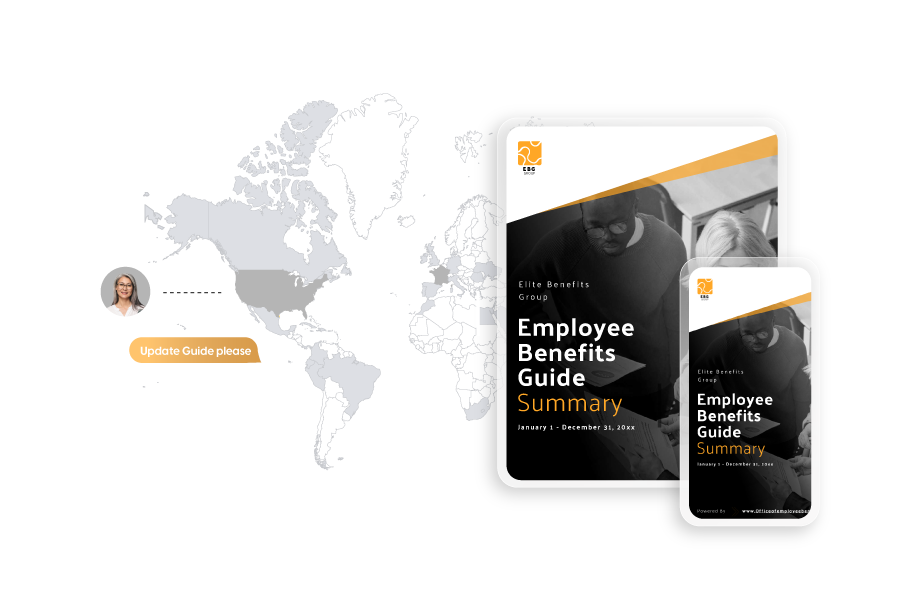
4. Customizable for every employer group
Flipbooks can be tailored with each client’s branding, colors, and layout preferences. This helps brokers deliver polished, personalized materials that elevate their service offering and strengthen their client relationships.
5. Engagement analytics for deeper insights
Flipbooks finally give brokers visibility into how employees interact with benefits information. You can see which pages get the most attention, where drop-offs happen, and what content triggers the most clicks—valuable insights you can share with HR teams.
6. Easy distribution across channels
Flipbooks can be shared through email, embedded in intranets or HR platforms, published on custom domains, or accessed via QR codes. This flexibility makes it easier for brokers to distribute materials and for employees to find them when they need them.
Digital benefits cards vs. traditional paper voucher programs
Traditional paper vouchers are familiar, but they come with clear limitations: they’re easy to lose, costly to print and replace, and offer no visibility into how employees actually use their benefits. Managing them at scale can also be time-consuming for both brokers and employer groups.
Digital benefits cards solve many of these issues. They can be issued instantly, updated or replaced at any time, and integrated with wellness or reimbursement programs. Most importantly, they offer usage analytics—giving brokers and HR teams real insight into engagement and benefit utilization. This helps streamline administration, reduce waste, and provide a more convenient, mobile-friendly experience for employees.
Case study: How an insurance brokerage modernized benefits communication with flipbooks
Pineywoods Benefits, a Texas-based insurance brokerage, needed a more professional, scalable way to deliver employee benefits information across dozens of employer groups. Their previous workflow—building PDFs for each client—was time-intensive, difficult to update, and didn’t give them insight into whether employees were actually reading the materials. As their book of business grew, they needed a solution that improved both efficiency and the employee experience.
By switching to Flipsnack, Pineywoods transformed their static guides into interactive flipbooks that were easier to personalize, update, and share. The brokerage now delivers modern, mobile-friendly benefits booklets that strengthen their value proposition and streamline open enrollment. Among the improvements they achieved:
- noticeably reduced production time for client-facing materials
- higher engagement from employees who preferred the digital format
- more consistent branding and easier customization across employer groups
- clearer insights that elevated their overall communication strategy

How to create employee benefits guides with Flipsnack
Creating professional, easy-to-use benefits guides doesn’t have to be a time-consuming process. With Flipsnack, brokers can transform any existing booklet—PDF or built from scratch—into an interactive flipbook that’s simple to update, customize, and distribute across every employer group they support.
1. Start with a template or upload your existing PDF
Import the guide you already use or choose from professionally designed templates. This allows you to keep your structure while upgrading the format to a modern, interactive flipbook.
2. Personalize it for each employer group
Add logos, brand colors, contact details, and plan variations. Locked elements keep your base layout consistent while making client-specific updates faster.
3. Add interactive elements that simplify benefits information
Embed videos, pop-up definitions, slideshows, or links to enrollment portals. These enhancements make complex plan details easier to understand and more engaging.
4. Enable real-time updates
Make instant changes to coverage details, dates, or contacts without creating a new file. One link always reflects the most accurate information.
5. Share in multiple formats
Distribute guides via email, QR code, intranet embed, or custom domain. Employees can access them from any device—no downloads required.
6. Use analytics to understand engagement
Track page views, reading time, clicks, and drop-off points. These insights help brokers improve communication and demonstrate added value to employer groups.
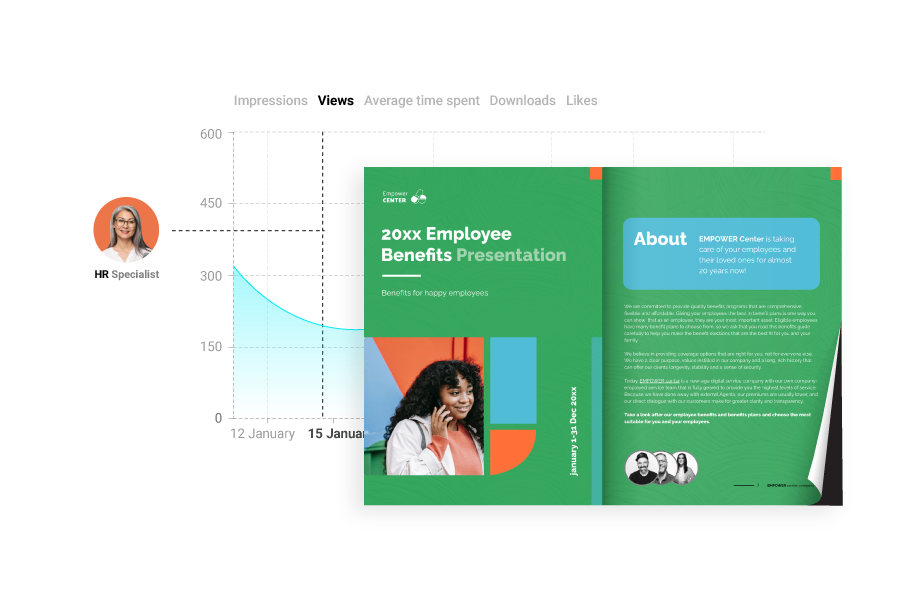
Conclusion on digital employee benefits
Printed and PDF employee benefits guides still have their place, but today’s employees expect clearer, more accessible, and more engaging ways to understand their benefits. For brokers, the shift toward digital communication isn’t just a trend—it’s an opportunity to deliver more value, strengthen client relationships, and streamline an otherwise time-intensive process.

Flipbook-based benefits guides give brokers the best of all worlds: professional presentation, mobile-friendly design, instant update capabilities, and engagement analytics that PDFs simply can’t match. They help employees make better decisions, help HR teams communicate more effectively, and help brokers stand out in a competitive market.
Frequently asked questions
Yes. Brokers can create a master benefits guide template and reuse it across all clients. Flipsnack allows you to lock certain elements (like structure or compliance text) while quickly customizing logos, colors, and plan details for each employer group.
Absolutely. Flipbooks can be shared privately via password protection, restricted to specific readers, or embedded into secure HR platforms and intranets. You control exactly who can open, view, download, or share the guide.
Yes. Flipbooks can be embedded into platforms like SharePoint, Workday, or HiBob. This keeps benefits information accessible in one central place and ensures employees always view the most up-to-date version.
